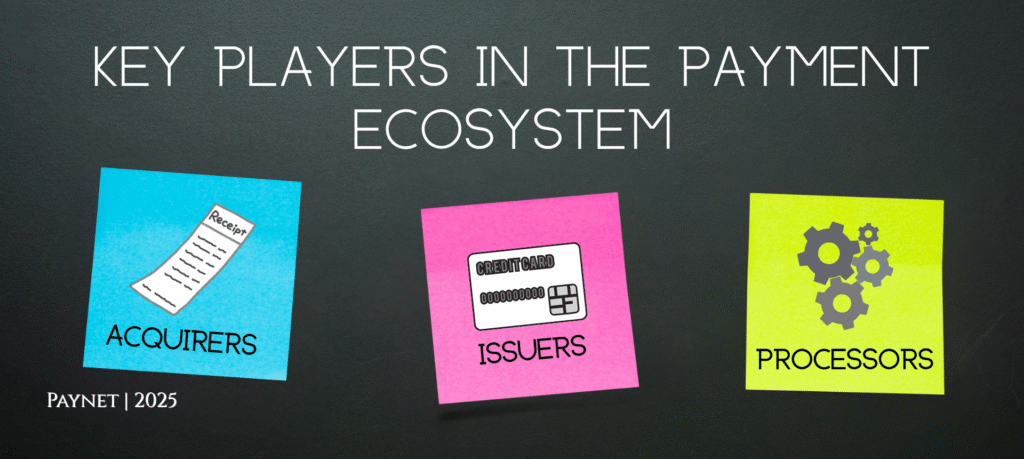User Behavior in Digital Wallet Usage: Insights That Are Shaping the Future of Digital Payments – [Cloned #1447]
Home UPI Growth and Adoption Insights: How India’s Favorite Payment System Is Shaping the Future of Finance Explore UPI growth...

Acquirers, issuers, and processors work together to enable secure, fast, and seamless online payment transactions.
When you click “Pay Now,“ it‘s instant-feeling—but behind the click is a highly orchestrated network of financial institutions, banks, and technology providers working in concert to make it so. The behind-the-scenes heroes? Acquirers, issuers, and payment processors.
These three parties comprise the backbone of the payment ecosystem, ensuring money is safely transferred from the customer to the merchant.
In this blog, we dissect who they are, what they do, and how they make the wheels of digital payments spin round smoothly.
For business owners, knowing how these roles work helps in choosing the right payment partners.
For developers, it informs better integration.
And for consumers, it builds trust in online transactions.
1. Acquirers (Acquiring Banks)
Definition
An acquirer is a bank or financial institution which processes credit or debit card payments on behalf of a merchant.
Responsibilities
Offers merchant accounts to businesses.
Receives card transaction requests through the payment gateway.
Talks to the issuer to ask for authorization.
Sends money to the merchant’s account once authorized.
Example Acquirers
In Short:
An acquirer is employed by the merchant and accepts payments.
2. Issuers (Issuing Banks)
Definition
The issuer refers to the bank or institution issuing the payment card (credit or debit) to the consumer.
Responsibilities
Verifies the cardholder’s information, balance, and credit limit.
Approves or rejects transactions.
Conducts fraud checks, OTP checks, and dispute resolution.
Prepares monthly statements (for credit cards).
Example Issuers
SBI (India)
In Short:
An issuer serves the customer and takes the decision to permit or reject a transaction.
3. Payment Processors
Definition:
A payment processor is the technology provider that enables the communication between merchants, issuers, card networks, and acquirers.
Responsibilities
Transmits encrypted transaction data.
Ensures compliance with PCI-DSS and other security standards.
Handles settlement and reconciliation.
Offers analytics, fraud detection, and reporting tools.
Types of Payment Processors
Front-end processors interact with card networks.
Back-end processors perform settlement and batch processing.
Example Payment Processors
Stripe
In Short:
A payment processor bridges the gap and takes care of the technical processes involved in each transaction.
Let’s visualize how a card transaction works using these roles:
Customer initiates payment via website/app.
Payment gateway sends details to the payment processor.
Processor contacts the acquirer.
Acquirer routes request to card network (Visa, Mastercard).
Card network connects to the issuer.
Issuer approves or declines.
Response flows back through the same path.
If approved, money is settled by the processor and transferred by the acquirer.
💡 Example: You shop online. HDFC (acquirer) collects the money, SBI (issuer) approves the debit, and Razorpay (processor) runs the entire backend.
|
Feature
|
Acquirer
|
Issuer
|
Payment Processor
|
|---|---|---|---|
|
Works for
|
Merchant
|
Customer
|
Both
|
|
Handles
|
Transaction receipt & funds
|
Card issuance & authorization
|
Data routing & backend
|
|
Key Role
|
Accepts money
|
Approves money
|
Connects and manages flow
|
|
Examples
|
HDFC, ICICI, Chase
|
SBI, Axis, Amex
|
Razorpay, Stripe, PayPal
|
Each player has unique compliance responsibilities:
Acquirers: Enforce merchant PCI-DSS compliance.
Issuers: Monitor cardholder behavior and fraud.
Processors: Handle encryption, tokenization, and secure data transfers.
🔒 Trustworthy gateways ensure that all three operate in sync with security best practices.
What Merchants Should Look For:
A reliable acquirer with fast settlement and low MDR.
An integrated processor offering analytics, fraud protection, and plugin support.
Gateways that support multiple issuer networks (Visa, Mastercard, RuPay, Amex).
For Developers:
Choose processors with robust APIs, SDKs, and sandbox environments.
Look for features like retry logic, smart routing, and chargeback management.
Understanding the roles of acquirers, issuers, and payment processors helps demystify the complex world of digital payments. Whether you’re a merchant scaling your platform or a customer making your first online payment—these players work together to ensure your transaction is secure, seamless, and successful.
👉 Want to simplify your payment infrastructure? Explore Paynet’s End-to-End Solutions for seamless integration and unmatched support.
Home UPI Growth and Adoption Insights: How India’s Favorite Payment System Is Shaping the Future of Finance Explore UPI growth...
Home User Behavior in Digital Wallet Usage: Insights That Are Shaping the Future of Digital Payments Explore changing user behavior...
Home New Features in UPI and Mobile Wallets 2025: Smarter, Safer & More Seamless Than Ever Explore the latest features...